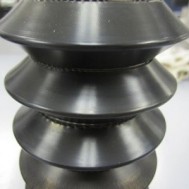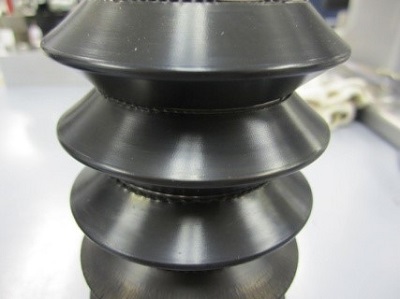Recently, we shared the three most common O-Ring design flaws with our readers. By identifying potential problems like insufficient gland volume, high tolerance levels and overcompression, engineers can resolve potential O-Ring issues before they happen.
Choosing the proper material is as crucial to the success of an O-Ring as the design. Key questions must be asked — what type of environment will the application face? What outside factors affect the material? A complete understanding of conditions and context will result in the choice of the proper sealing material.
The Three Most Common O-Ring Material Issues
1. Ozone
Another recent Apple Rubber blog post discussed the link between ozone and rubber deterioration, noting design considerations that all engineers should review. Many applications take place in an outdoor environment, leaving materials prone to ozone attack.
“When rubber polymers are attacked by ozone, a compounder will use waxes that scavenge up the free radicals created by the ozone before they attack the polymer,” Apple Rubber Materials Manager John Tranquilli says. “This is commonly seen when purchasing new tires – consumers can actually see the wax on the new tire’s surface.”
One common mistake, however, is the use of Nitrile (Buna-N) rubber.
NBR seals are considered standard and commonly used. NBR is ideal for engine applications, but not for applications where weathering is a concern. NBR contains weak bonds that will crack in the presence of even small levels of ozone.
There is a better way: hydrogenation.
“HNBR is similar to NBR, but adds the hydrogen component,” Tranquilli notes. “Hydrogenation of the double bond in the polymer chain adds an element of resistance and limits ozone attack on the material. Using HNBR will greatly prolong the life of the seal when it comes to this type of application.”
2. Temperature Range
Aside from external factors like ozone, it is important to know the temperature range of a compound chosen for an O-Ring. Where will the application be used? What types of temperatures will the material be exposed to? Will temperatures vary over the course of its lifetime?
“Applications used in Texas oil fields, for example, cannot be comparable to applications used in Canada’s oil fields,” Tranquilli says. “All possible environments must be taken into consideration. That process requires full communication between us and the customer beforehand.”
Some NBR compounds with very low fuel swell may only function to -25°C. Most NBR compounds can reach temperatures as low as -40°C or, in some cases, even -65°C. Clearly, within a given polymer, there may be different low temperature service ranges. Be sure to speak with the experts to make sure your compound meets the appropriate temperature range.
3. Fluid swell
There are multiple levels of fuel swell. The amount of swell is dependent on the chemistry of the oil and the temperature at which exposure occurs. Manufacturers have spent time and money developing elastomers that swell very little when exposed to oil or water. Swelling will continue until the internal stresses inside the elastomer reach equilibrium. Too much swell can cause cracking, deterioration or premature failure.
“With FKM, for example, there are typically four different Fluorine levels. As the Fluorine levels increase, the lower the swell for fluids will be,” Tranquilli says. “It’s critical to keep fluid swell in mind, because we need the size to be exact for each given application.”
To avoid deterioration and over-swell, know your application’s environment. This will allow engineers, chemists and manufacturers to choose the right polymer to allow the application to fully function properly.
Questions? Share them with us in the Comments below – or Tweet us @AppleRubber.

